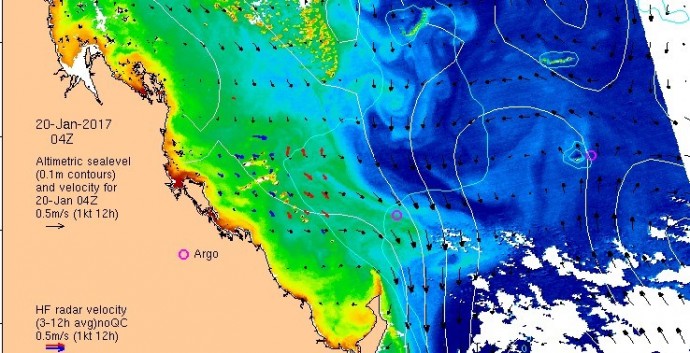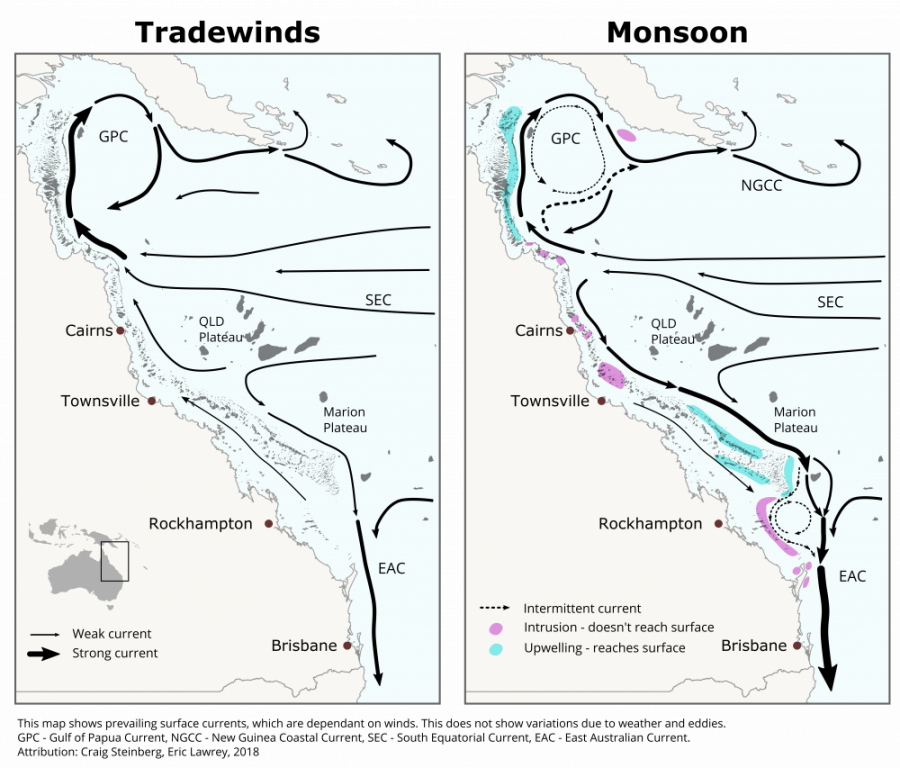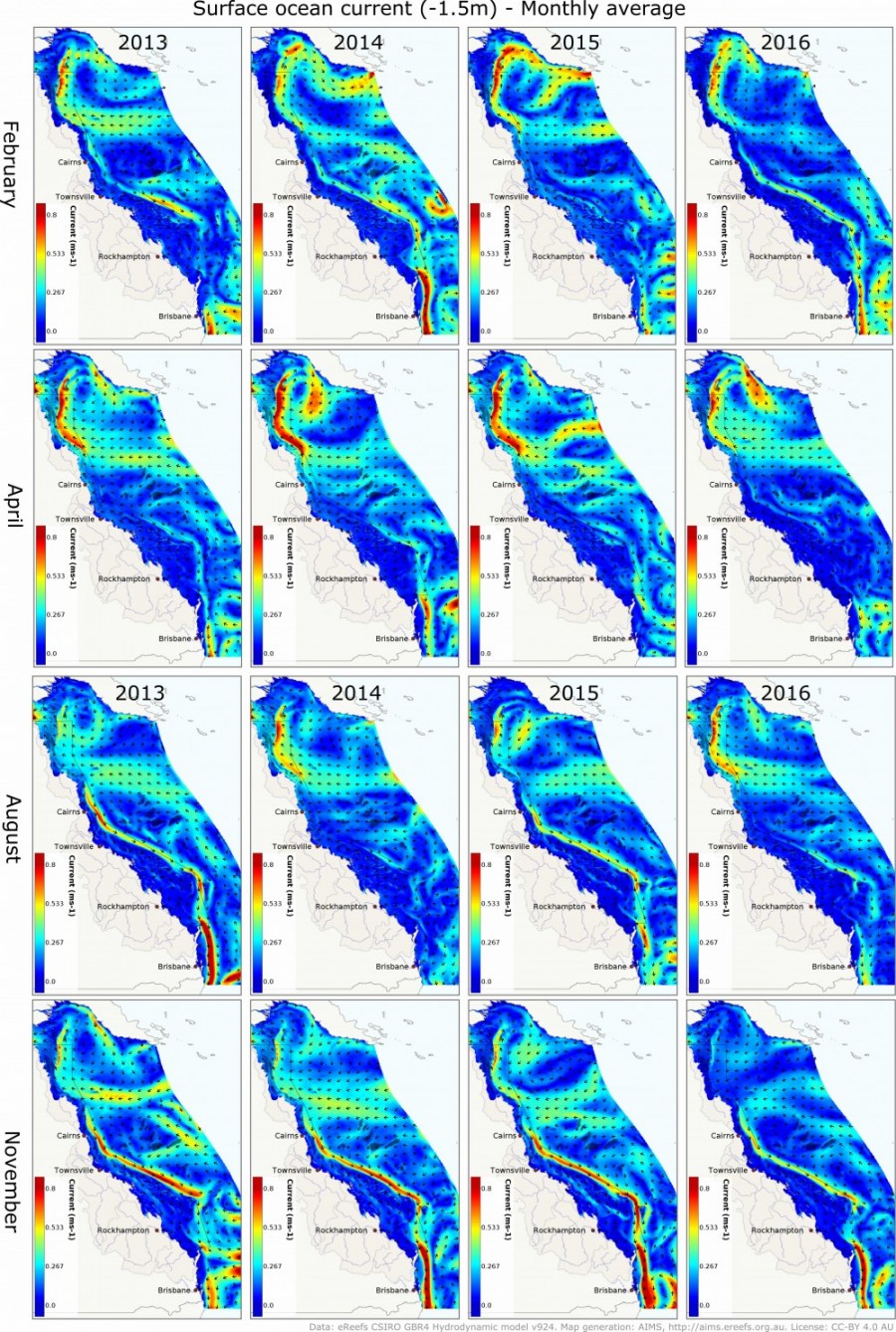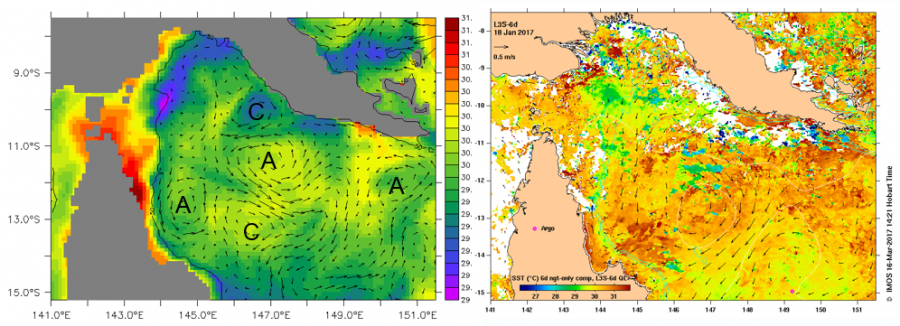Circulation and Upwelling
Introduction to Circulation and Upwelling and why it is important
Ocean currents are known to be the major mechanism by which the values across the entire northeast Australian seascape are both defined and connected. For example, by facilitating dispersal of larvae and particles (Wolanski, 2016) or the propagation of climate features (e.g. marine heatwaves that can cause coral bleaching).
The surface circulation of the Coral Sea and the Queensland continental shelf is the primarily driven by two main phenomena:
- The prevailing winds that vary from moderate to strong southeast (SE) Trades from April to November and weaker northwest (NW) monsoons from December to March. These tend to dominate the net flow in coastal areas and where the reef matrix impedes the Coral Sea western boundary currents such as in the Swains and Pompeys group of reefs.
- The westward flowing Southern Equatorial Current (SEC) that bifurcates at the Queensland continental shelf into the equatorward flowing Gulf of Papua Current (GoP) and the poleward East Australian Current (EAC).
Upwelling is a process in which deep, cold and nutrient rich water rises toward the surface. These nutrients “fertilize” the warmer oligotrophic surface waters surface so they will have higher biological productivity. Both reduced temperatures and nutrients delivered via upwelling can be mixed, dissipated and utilised by the biota on the shelf. In some regions the upwelled waters may not reach the surface and so we refer to these as intrusions (Benthuysen et al, 2016).
Key concepts that relate to its connectivity
Low frequency SE trade winds are highly spatially correlated over the majority of the Coral Sea, which commonly reach 25 to 30 knots. The winds reinforce the northward flowing GoP current and oppose the poleward flowing EAC causing a seasonal minimum in transport and occasional surface flow reversals (figures 1 & 2). Closer to the coast the SE trade winds dominate the inner shelf resulting in well mixed northward coastal currents. Modelling studies in the central GBR suggest there is a disconnect between well mixed, coastal wind forced currents moving north and mid-lagoon EAC driven currents moving toward the south (Brinkman et al, 2002). Overall, SE trade winds force surface waters onshore and will suppress upwelling along the coast and shelf edge. During the north-west monsoon, winds tend to be less consistent and lower in strength. Thus classical wind –driven or Ekman driven will result in episodic coastal and shelf edge upwelling to replace the surface waters transported offshore by the wind.
Subsurface intrusions and upwelling through thermocline uplift along the Queensland shelf edge can occur as a result of a large range of oceanographic processes: Pacific Decadal Oscillation, ENSO, EAC and GoP current variability, impinging eddies, Rossby waves, tides, wind forced continental shelf waves and internal waves and tides (Wolanski, 1994).
Mechanisms that enhance the delivery of sub-thermocline waters to the shelf include bottom generated Ekman layer currents, tidal induction, geostrophic pumping and favourable winds and currents. The intruded waters may penetrate to the GBR lagoon but remain subsurface, such as found in the central GBR. Waters however can mix upwards around the coral reef fringes within the reef matrix assisted by vertical mixing provided by the tides, wind and wave activity. Figure 1 provides an indication of the locations along the GBR where the upwelling and intrusions occur during the monsoon season. The eastern Torres Strait, outer ribbon reefs in the northern GBR, Swains and Pompeys group are well known areas of persistently cooler surface waters from SST climatologies. During the trade winds there surface mixed layer deepens and cools, so any upwelling or intrusive activity is less apparent.
Torres Strait
Circulation in the Coral Sea is dominated by the clockwise Gulf of Papua Current that forms from a bifurcation of the North Vanuatu Jet off Lizard Island. As the current approaches Papua New Guinea, it diverges eastward and passes through the Louisiade Archipelago. A closed gyre can exist in the Gulf of Papua allowing a closed loop for any propagules to recirculate in this area. During summer the strength of this circulation is reduced and can even reverse as anti-clockwise eddies form in the Gulf of Papua (Figure 3). The implications of this are significant as the now poleward boundary current near the shelf break allows the thermocline to lift and so upwelling of cool, nutrient rich waters are more readily available to occur on the shelf of the eastern Torres Strait.
The net flow through the Torres Strait is deemed to be highly seasonal and driven by sea level gradients caused by the build-up of waters in the northern Coral Sea by the southeast trade winds from April to November and conversely the northwest monsoon in the Gulf of Carpentaria from December to March. Wolanski et al. (2017) have hypothesised that a significant amount of hot water from the Gulf moved through the Torres Strait further exacerbating the coral bleaching event in the region.
Great Sandy Strait
This region is dominated by the poleward flow of the East Australian Current that is nearly at full strength as a western boundary current after the confluence of the jets in the Coral Sea and the traversing of the Marion Plateau. Upstream of Fraser Island, the Capricorn Eddy can form, enhancing the northwest flow from the southeast trade winds on the outer shelf of the Capricorn Bunker Group of reefs (Weeks et al. 2010). This can allow a northward coastal boundary current to form facilitating south to north connectivity. South of Waddy point an eddy can form in the lee of Fraser Island inshore of the EAC causing significant upwelling and resulting in a phytoplankton bloom (Brieva et al. 2015; Figure 4).
References
Brieva, D., Ribbe, J., Lemckert, C. (2015) Is the East Australian Current causing a marine ecological hot-spot and an important fisheries near Fraser Island, Australia? Estuarine, Coastal and Shelf Science, 153:121 – 134.
Benthuysen, J. A., H. Tonin, R. Brinkman, M. Herzfeld and C. Steinberg (2016) Intrusive upwelling in the Central Great Barrier Reef, J. Geophys. Res. Oceans, 121, doi:10.1002/2016JC012294.
Brinkman R, Wolanski E, Deleersnijder E, McAllister F and Skirving W (2002) Oceanic inflow from the Coral Sea into the Great Barrier Reef. Estuarine, Coastal and Shelf Science 54, 655–668.
Steinberg C (2007) Impacts of climate change on the physical oceanography of the Great Barrier Reef, pp 51-74. In Johnson JE and Marshall PA [eds.], Climate Change and the Great Barrier Reef. Great Barrier Reef Marine Park Authority & Australian Greenhouse Office. Available at: http://www.gbrmpa.gov.au/outlook-for-the-reef/climate-change/how-climate-change-can-affect-the-reef/great-barrier-reef-vulnerability-assessment
Weeks S.J, Bakun A, Steinberg C, Brinkman R, Hoegh-Guldberg O (2010) The Capricorn Eddy: a prominent driver of the ecology and future of the southern Great Barrier. Coral Reefs: 29: 975-985.
Wolanski E (1994) Physical oceanographic processes of the Great Barrier Reef. CRC Press, Marine Science Series, Boca Raton, Florida.
Wolanski E (2016) Bounded and unbounded boundaries – Untangling mechanisms for estuarine-marine ecological connectivity: Scales of m to 10,000 km – A review. Estuarine, Coastal and Shelf Science, Volume 198, Part B, Pages 378-392, https://doi.org/10.1016/j.ecss.2016.06.022
Wolanski E, Andutta F, Deleersnijder E, Li Y. and Thomas C. J. (2017) The Gulf of Carpentaria heated Torres Strait and the Northern Great Barrier Reef during the 2016 mass coral bleaching event. Estuarine, Coastal and Shelf Science, 194, 172-181









